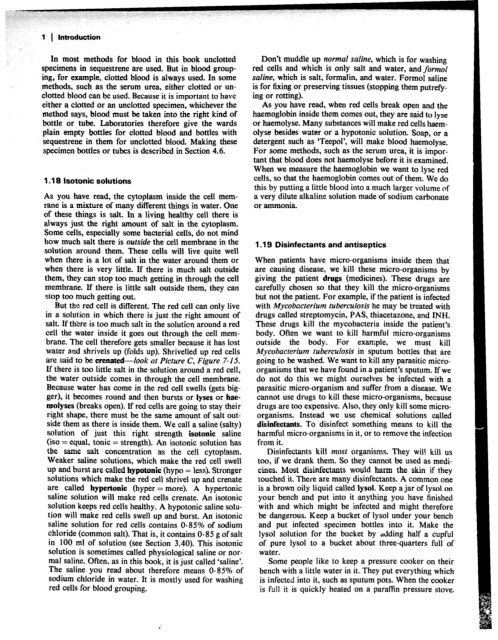MICROFICHE REFERENCE LIBRARY
MICROFICHE REFERENCE LIBRARY
MICROFICHE REFERENCE LIBRARY
Create successful ePaper yourself
Turn your PDF publications into a flip-book with our unique Google optimized e-Paper software.
1 1 IntroductionIn most methods for blood in this book unclottedspecimens in sequestrene are used. But in blood grouping,for example, clotted blood is always used. In somemethods, such as the serum urea, either clotted or unclottedblood can be used. Because it is important to haveeither a clotted or an unclotted specimen, whichever themethod says, blood must be taken into the right kind ofbottle or tube. Laboratories therefore give the wardsplain empty bottles for clotted blood and bottles withsequestrene in them for unclotted blood. Making thesespecimen bottles or tubes is described in Section 4.6.1 .I 8 Isotonic solutioimAs you have read, the cytoplasm inside the cell memraneis a mixture of many different things in water. Oneof these things is salt. In a living healthy cell there isalways just the right amount of salt in the cytoplasm.Some cells, especially some bacterial cells, do not mindhow much salt there is outside the cell membrane in thesolution around them. These cells will live quite wellwhen there is a lot of salt in the water around them orwhen there is very little. If there is much salt outsidethem, they can stop too much getting in through the cellmembrane. If there is little salt outside them, they canstop too much getting out.But the red cell is different. The red cell can only livein a solution in which there is just the right amount ofsalt. If thtre is too much salt in the solution around a redcell the water inside it goes out through the cell membrane.The cell therefore gets smaller because it has lostwater and shrivels up (folds up). Shrivelled up red cellsare said to be crenated-look at Picture C, Figure 7-15.If there is too little salt in the solution around a red cell,the water outside comes in through the cell membrane.Because water has come in the red cell swells (gets bigger),it becomes round and then bursts or lyses or haemolyses(breaks open). If red cells are going to stay theirright shape, there must be the same amount of salt outsidethem as there is inside them. We call a saline (salty)solution of just this right strength isotonic saline(iso = equal, tonic = strength). An isotonic solution hasthe same salt concentration as the cell cytoplasm.Weaker saline solutions, which make the red cell swellup and burst are called hypotonic (hypo = less). Strongersolutions which make the red cell shrivel up and crenateare called hypertonic (hyper = more). A hypertonicsaline solution will make red cells crenate. An isotonicsolution keeps red cells healthy. A hypotonic saline solutionwill make red cells swell up and burst. An isotonicsaline solution for red cells contains O-,3$ of sodiumchloride (common salt). That is, it contains 0.85 g of saltin 100 ml of solution (see Section 3.40). This isotonicsolution is sometimes called physiological saline or normalsaline. Often, as in this book, it is just called ‘saline’.The saline you read about therefore means 0.85% ofsodium chloride in water. It is mostly used for washingred cells for blood grouping.Don’t muddle up normal saline, which is for washingred cells and which is only salt and water, and form01saline, which is salt, formalin, and water. Form01 salineis for fixing or preserving tissues (stopping them putrefyingor rotting).As you have read, when red cells break open and thehaemoglobin inside them comes out, they are said to lyseor haemolyse. Many substances will make red cells haemolysebesides water or a hypotonic solution. Soap, or adetergent such as ‘Teepol’, will make blood haemolyse.For some methods, such as the serum urea, it is importantthat blood does not haemolyse before it is examined.When we measure the haemoglobin we want to lyse redcells, so that the haemoglobin comes out of them. We dothis by putting a little blood into a much larger volume ofa very dilute alkaline solution made of sodium carbonateor ammonia.1 .I 9 Disinfectants and antisepticsWhen patients have micro-organisms inside them that’are causing disease, we kill these micro-organisms bygiving the patient drugs (medicines). These drugs arecarefully chosen so that they kill the micro-organismsbut not the patient. For example, if the patient is infectedwith Mycobacterium tuberculosis he may be treated withdrugs called streptomycin, PAS, thiacetazone, and INH.These drugs kill the mycobacteria inside the patient’sbody. Often we want to kill harmful micro-organismsoutside the body. For example, we must killMycobacterium tuberculosis in sputum bottles that aregoing to be washed. We want to kill any parasitic microorganismsthat we have found in a patient’s sputum. If wedo not do this we might ourselves be infected with aparasitic micro-organism and suffer from a disease. Wecannot use drugs to kill these micro-organisms, becausedrugs are too expensive. Also, they only kill some microorganisms.Instead we use chemical solutions calleddisinfectants. To disinfect something means to kill theharmful micro-organisms in it, or to remove the infectionfrom it.Disinfectants kill most organisms. They will kill ustoo, if we drank them. So they cannot be used as medicines.Most disinfectants would harm the skin if theytouched it. There are many disinfectants. A common oneis a brown oily liquid called lysol. Keep a jar of lysol onyour bench and put into it anything you have finishedwith and which might be infected and might thereforebe dangerous. Keep a bucket of lysol under your benchand put infected specimen bottles into it. Make thelysol solution for the bucket by ddding half a cupfulof pure lysol to a bucket about three-quarters full ofwater.Some people like to keep a pressure cooker on theirbench with a little water in it. They put everything whichis infected into it, such as sputum pots. When the cookeris full it is quickly heated on a paraffin pressure stove.
















